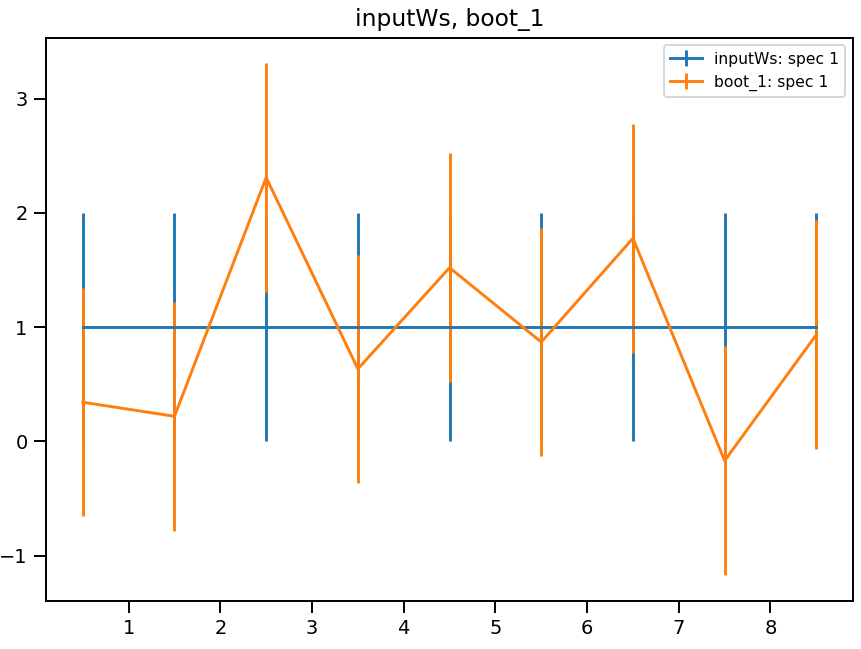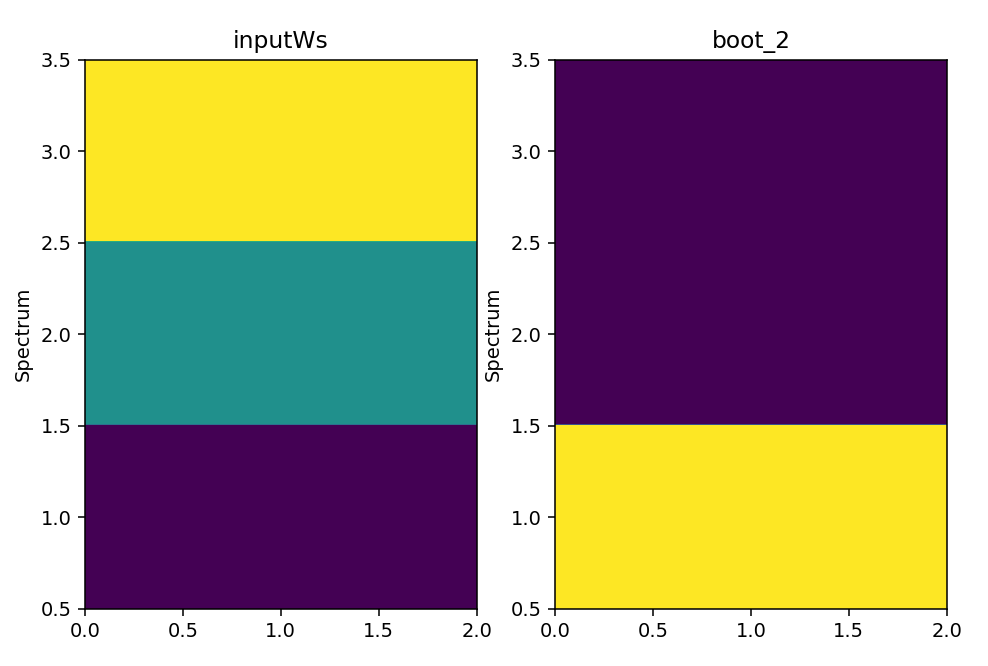CreateBootstrapWorkspaces v1¶
Summary¶
Creates a randomly simulated workspace by sampling from the input data.
Properties¶
Name |
Direction |
Type |
Default |
Description |
|---|---|---|---|---|
InputWorkspace |
Input |
Mandatory |
Input Workspace containing data to be simulated |
|
Seed |
Input |
number |
32 |
Integer seed that initialises the random-number generator, for reproducibility |
NumberOfReplicas |
Input |
number |
100 |
Number of Bootstrap workspaces to simulate. |
BootstrapType |
Input |
string |
ErrorSampling |
Type of bootstrap sampling to use. ErrorSampling samples at each data point, while SpectraSampling samples each spectra with repetition. Allowed values: [‘ErrorSampling’, ‘SpectraSampling’] |
OutputWorkspaceGroup |
Output |
WorkspaceGroup |
bootstrap |
Name of output workspace. |
Description¶
The algorithm generates simulated workspaces by randomly sampling from the input workspace. Meant to be used for creating many workspaces that are randomly simulated from the starting workspace, for performing the Bootstrap technique. Bootstrap works by running a single routine or procedure on the many simulated replicas and then comparing the statistical deviation of the results at the end. The Bootstrap replicas can be generated in two ways:
BootstrapType=ErrorSampling: This type of sampling changes the value of each Y data point by randomly sampling from a normal distribution with the mean at Y and deviation of the error at that datapoint, i.e.newDataY = Gaussian(originalDataY, originalDataE). This means that data from one spectrum does not have any influence on the data from another spectrum, as the sampling is done point by point. The errors of the newly created workspaces are set to zero to conform with the theory of Bootstrap.
BootstrapType=SpectraSampling: This type of sampling samples the spectrum numbers with repetition. This means that each row of the workspace is equal to an original row picked at random from the input workspace. In practice, this means that each spectra is calculated asboot_sample_ws.dataY(index) = input_ws.dataY(Uniform[0, numberOfHistograms]). This kind of bootstrap might make sense when the input workspace contains spectra resulting from measurements of the same observable that, in the absence of noise and background, would have been supposed to have been identical. An example would be a collection of the momentum distributions of the same isotopic species measured by different detectors
Usage¶
Example - CreateBootstrapWorkspaces
# import mantid algorithms, numpy and matplotlib
from mantid.simpleapi import *
import matplotlib.pyplot as plt
import numpy as np
dataX = [0,1,2,3,4,5,6,7,8,9] # or use dataX=range(0,10)
dataY = [1,1,1,1,1,1,1,1,1] # or use dataY=[1]*9
dataE = [1,1,1,1,1,1,1,1,1] # or use dataY=[1]*9
inputWs = CreateWorkspace(dataX, dataY, dataE)
CreateBootstrapWorkspaces(
InputWorkspace=inputWs,
Seed=32,
NumberOfReplicas=10,
BootstrapType="ErrorSampling",
OutputWorkspaceGroup="bootErr"
)
plotSpectrum(["inputWs", "bootErr_1"], indices=0, error_bars=True)

from mantid.simpleapi import *
import matplotlib.pyplot as plt
import numpy as np
dataX = [0,1,2,0,1,2,0,1,2] # or use dataX=range(0,10)
dataY = [1,1,1,2,2,2,3,3,3] # or use dataY=[1]*9
dataE = [1,1,1,1,1,1,1,1,1] # or use dataY=[1]*9
inputWs = CreateWorkspace(dataX, dataY, dataE, NSpec=3)
CreateBootstrapWorkspaces(
InputWorkspace=inputWs,
Seed=32,
NumberOfReplicas=10,
BootstrapType="SpectraSampling",
OutputWorkspaceGroup="bootSpectra"
)
fig, axes = plt.subplots(nrows=1, ncols=2, subplot_kw={'projection':'mantid'})
axes[0].imshow(inputWs, origin = 'lower', cmap='viridis', aspect='auto')
axes[0].set_title("inputWs")
axes[1].imshow(mtd["bootSpectra_2"], origin = 'lower', cmap='viridis', aspect='auto')
axes[1].set_title("bootSpectra_2")
# fig.show()

Note
In the case of spectra sampling, the sampling is done with repetition, meaning that an original spectra might be selected multiple times in the bootstrap replica. You can see this behaviour in the previous image.
Categories: AlgorithmIndex | Simulation
Source¶
C++ header: CreateBootstrapWorkspaces.h
C++ source: CreateBootstrapWorkspaces.cpp